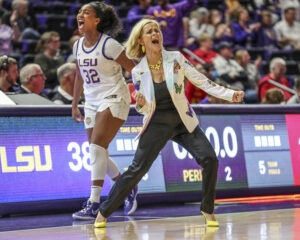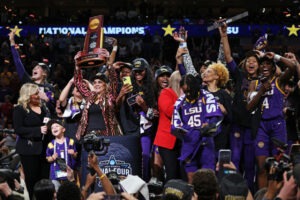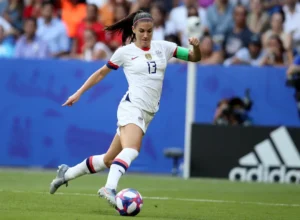Anti-Feminism in Modern Day Sports
Published on March 8, 2024, at 4:17 p.m.
by Malia Elliott.
Did you know that only 41% of female sports teams are actually coached by a woman? Did you know that some argue how the media portrays female athletics makes it seem less entertaining? In a time when female athletics is underrepresented and the number of female professionals in the industry is low, how do these factors affect the few who are involved? Are the women who play collegiate and professional athletics treated fairly and given the same luxuries as the men? Are the women who work in collegiate and professional athletics given the same seat at the table as the men?
This article will look at two well-known and rather successful college coaches and their reputation in the media to provide some insight into how females are treated in the sports world.
Kim Mulkey, LSU women’s basketball head coach, and Nick Saban, former Alabama football head coach, are both the arguable “goats” (greatest of all time) in their respective sports. The two coaches also share strikingly similar mannerisms and habits when speaking with sports media.

Saban has long been praised and admired in the football world, which is not shocking considering his record at Alabama is 183-25. Along with his reputation for winning, Saban carries a reputation for being cold to the media. But what is interesting about Saban’s reputation is people seem to love and enjoy his attitude. Some even go as far as to say his attitude toward the media and treatment of players are “protective.”
Mulkey, on the other hand, acts in a similar way to Saban and carries an equally impressive record (713-116), but she is considered a brat, stuck-up and has her successes compared to past coaches.
In explaining this difference in perceptions, Brett Hudson, a University of Alabama adjunct instructor, said, “There is a difference between reluctantly doing media and being dismissive of media.”
Is this a Mulkey issue, or a media representation issue? Is Mulkey given the chance to display herself properly or is she automatically written off?

In the 2023 basketball season, LSU women’s basketball won the national championship, which helped them gain a lot of media coverage. Mulkey was shown multiple times in media yelling at referees, players and other coaches, resulting in some not-so-great media attention. One fan even went as far as to say Mulkey is a “disgrace.”
National Basketball Association (NBA) legend Magic Johnson showed his support for Mulkey after she secured the national championship ring but faced harsh backlash from fans for his support of the coach.
In another example, after a rather long-winded rant to the media, Saban was given the opportunity to explain his motivation for ranting, with the media simply writing it off as him “trying to send a message to his players.” But when Mulkey attempted to keep the reason for a player’s suspension private, LSU’s own fan site, tigerrag.com, said she “doesn’t get media relations 101.”
Professor Tom Arenberg of The University of Alabama provided an interesting insight, stating, “Saban can get away with stuff; Kim Mulkey can’t. I’m not justifying that.”
Which begs the question, why is that? How can two coaches with close to equal success be viewed so differently? Is there really a difference in how these coaches treat the media? Or is this a representation of female athletics issue?
“Look on social media, the abuse that female coaches take. That female athletes take. The abuse that female sports writers take. It’s horrifying,” said Arenberg. “Yeah, there is still some chauvinism in the world.”
For example, Alex Morgan, member of the U.S. Women’s National Team, is

the highest-paid female soccer player, making $800,000 a year, which sounds like a lot of money but pales in comparison to Cristiano Ronaldo’s $136 million-a-year contract. The average NBA player makes $8.5 million a year, but the average WNBA player makes roughly $116,000 a year.
“I think it is mostly how [Mulkey] speaks to the media,” Hudson noted, “but there is something to be said about the lack of exposure of women’s sports.”
As mentioned previously, women’s athletics is far underrepresented. One study found that in Southern California, women athletes receive less than 4% of coverage on sports news shows but account for over 40% of athletes.
Jacqueline Vinson, public relations intern for the Los Angeles Rams, said, “It definitely is a bad PR look for athletics that in 2024 women are still underrepresented and underappreciated.”
As pointed out by Global Sport Matters, women who work in sports in any capacity still face many trials and tribulations when simply trying to complete their jobs. Although collegiate and professional athletics are attempting to become a more inclusive space, is it too little, too late to save the image of sports as an inclusive community? Many companies, like Nike, are beginning to run advertising campaigns that showcase women in sports, which is helping to make strides for sports and PR.
While women’s sports and women working in sports are rapidly on the rise, there is still a massive gap between women’s and men’s sports. Kim Mulkey is what most would consider a trailblazer for female sports, and while she might face some negative media attention, she is helping females in sports make huge strides toward creating a more equal future. As more women start to work in sports media and in other capacities in the industry, this gap in reputation will soon grow smaller and smaller.
Until then, Kim Mulkey will continue fighting for females’ right to be in the sports world.




